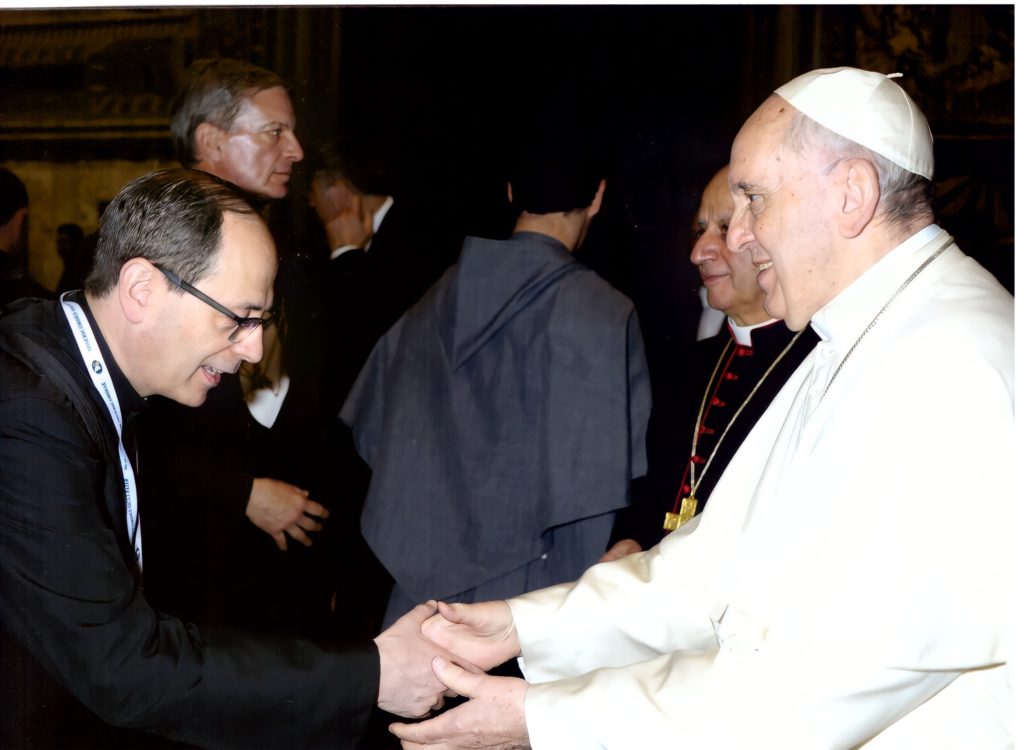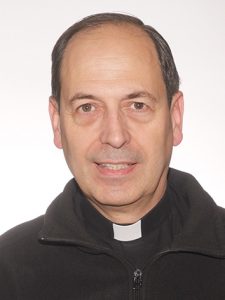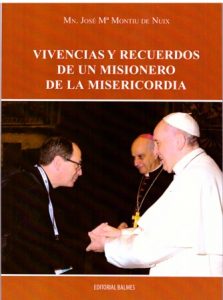Postulator Reflects on Attraction of Saints
Bravery and Courage, Audacity and Fervor, Joy and Humor

In this interview for Exaudi, Father Jose Maria Montiu de Nuix, missionary priest of mercy, Postulator for the Cause of Saints, Doctor in Philosophy, Collaborator in Global Catholic Radio, and a voice in several means of communication, talks about his experience as a missionary priest in additions to answering questions and curiosities on the existence, purpose, and attraction of the life of Saints.
Pope Francis appointed you “Missionary of Mercy.” What does it mean to be a Missionary of Mercy? What is the mission? Can you share your experiences with us?
The appointment of Missionaries of Mercy is reserved to the Pope. Pope Francis said that the Missionaries of Mercy are a sign of the Church’s maternal solicitude for the People of God, so that it enters into the depth of the richness of the mystery of mercy, so essential for the faith.
Understood as sins reserved to the Holy See, are those sins that the Holy See has reserved in order to forgive them. We, Missionaries of Mercy, are priests appointed by the Pope with the mission and with the authority to forgive many of the sins reserved to the Holy See.
The mission of the Missionaries of Mercy is, especially, to be at the service of mercy. We must preach the message of mercy and, very especially, we must be very available to administer the Sacrament of Mercy. This, done in such a way, that we facilitate the faithful’s entering into contact with God’s mercy.
In fact last year I took this from a book entitled “Experiences and Memories of a Missionary of Mercy,” of the prestigious Balmes Publishing house. I take from this book some experiences and memories.
I remember with special pleasure seeing Pope Francis hearing Confessions and himself going to Confession, just like many other people going to Confession in the Vatican Basilica of Saint Peter.
 In 2016, in Pope Francis’ first World Meeting with Missionaries of Mercy, many of us Missionaries of Mercy were able to greet him personally. Some had a more or less long conversation with him. In the midst of that filial bustle, in which we expressed our affection to the Pope, I had the great joy of giving him a big kiss, a good kiss, on the hand. It was impressive to see a Pope so close, so simple, so good and so paternal. We had before us someone whom we could call ‘daddy’ spiritually. So the Most Holy Father spent much time greeting personally those of us Missionaries of Mercy who were gathered there. What a beautiful image of ecclesial communion!
In 2016, in Pope Francis’ first World Meeting with Missionaries of Mercy, many of us Missionaries of Mercy were able to greet him personally. Some had a more or less long conversation with him. In the midst of that filial bustle, in which we expressed our affection to the Pope, I had the great joy of giving him a big kiss, a good kiss, on the hand. It was impressive to see a Pope so close, so simple, so good and so paternal. We had before us someone whom we could call ‘daddy’ spiritually. So the Most Holy Father spent much time greeting personally those of us Missionaries of Mercy who were gathered there. What a beautiful image of ecclesial communion!
During the Jubilee Year, given that in the Sacrament of Confession the love of God is poured very especially in our souls, I compared receiving the Sacrament to a kiss of Jesus. After this, I know that there were those that approached the confessional, as a beautiful flower, intensely moved, saying that they would go to Confession to receive good Jesus’ kiss.
In 2018, during the Pope’s Second World Meeting with Missionaries of Mercy, I also had the joy of greeting the Pope personally and of kissing his hand. There are gestures that say more than a thousand words. In fact, after having received us as a group, the Pope wished to greet personally, one by one — the close to 600 Missionaries of Mercy present there! This gave the meeting a very personal, affectionate, familiar, heartfelt tone. Just as Christ, in the Last Supper, although being Lord, washed the feet of His disciples, so the Pope, the Vicar of Christ, he who takes Christ’s place on earth, began to serve us, welcoming us one by one, greeting us one by one. It’s a mercy of the Pope, an affection of his paternal heart, a delicacy, a beat, cordiality, a kindness, a proximity, which comforts and encourages us, and leaves our heart more united to his. Pope Francis is a Pope who loves and is loved. Moreover, the challenge is laid down, namely, that we priests, who in the Sacrament of Mercy also act in persona Christi,’ must put more heart, more affection, more cordiality when dealing with the penitent. The priest’s heart is Christ’s heart.
In summary, it has been a great joy to be an instrument of the embrace God gives those going to Confession, Sacrament of Peace, and Joy. I remember a faithful who told me that no one had ever seen someone he knew happier after he went to Confession. Let us thank God!
“Young Witnesses of Christ” is a book that gives examples of the life and faith of some children, adolescents, and young people of our time. Can you tell us how this lovely project was born and something about the most outstanding virtues of these lives so full of heroism . . .
Those of us who are concerned in Spanish dioceses with the Causes of Saints, especially writer and priest Felix Uribe, were in a national meeting, held in the building of the Spanish Episcopal Conference. We were also at the doors of the impressive 26th World Youth Day (WYD) in Madrid, which saw the presence of Pope Benedict XVI. Thus, in a natural way, not by the initiative of the Bishops, but in a merely private way, as friends and acquaintances, we thought it would be very good if the young people had examples of those edifying young lives that we knew well and that would be especially edifying. They could help them to be defenders of life from the moment of conception, to love holy purity, to be young people of integrity, to have a great ideal of love, to discover new and beautiful horizons, etc. Some of these interesting lives were still not very known by the public in general. That’s how the book came into being, made up of 17 exemplary lives, written by 14 experts, coordinated by the Founder and Director of Edibesa, and a very well-known writer on Saints, the Dominican Reverend Father Jose Antonio Martinez Puche, and by a servant. A key element of this work was having so many well-prepared authors.
A Professor of the Roman Urban University, the self-same missionary Maruja Serrano, talked about the great generosity of a stupendous young Italian woman, Saint Gianna Beretta, who during her pregnancy had to choose between her life and that of her unborn daughter. Her decision was firm: save the little girl. This good, smiling, affectionate doctor and pediatrician, who always had kind words for her patients and was a generous mother of a numerous family, died whispering constantly: Jesus, I love You. Jesus, I love you — a fantastic woman!
The young Argentine Focolare member Cecilia Badano, first Focolare Blessed, beatified a few months before the book appeared, was outstanding in the way she bore the bone cancer that would end her life at 18. A good sportswoman, she lost the use of her legs, but Jesus Christ gave her wings. She certainly suffered, but her soul sang. She is a splendid light for today’s youth!
 Italian Focolare Alberto Michelotti was a pious boy, sportsman, a young man of many friends, who died on a mountain, who must be described as the climber of summits of love.
Italian Focolare Alberto Michelotti was a pious boy, sportsman, a young man of many friends, who died on a mountain, who must be described as the climber of summits of love.
Jewish Etty Hillesun, who was sacrificed in the Jewish Holocaust of the Auschwitz extermination camp, who in those terrible hours opened a window in her heart to Heaven, finding consolation in God through prayer.
Spanish Anita Sole, sister of the holy man and Claretian Father Jose Maria Sole Roma, Franciscan novice, who died at 18. She lived her love of God with wonderful youthful simplicity and profundity. If you knew the happiness my soul enjoys! Oh, how sweet it is to dwell in Jesus’ affectionate company! I, Jose, don’t seem to be living on earth, but I live in Heaven. How much we must thank Jesus for having called us to be among the number of his intimate children, enjoying Love’s caresses!
The 12-year-old Chilean girl, Blessed Laura Vicuña, was a poem of purity, sacrifice, and filial love. She offered herself for the conversion of her mother, who had a lover. “Mommy, I’m going to die. I myself asked this of Jesus. Two years ago I offered Him my life to obtain the grace that you return to Him. Mommy, if only before dying I could have the joy of knowing that you are in peace with God.” Her mother promised her that she would convert. And the girl’s last words were: “Thank you, Jesus! Thank you, my Mother! Now I die happy!”
Young seminarian Blessed Manuel Aranda, who faced with the dilemma of blaspheming or dying, as a martyr. Ignacio Trias was a courageous apostle in the midst of the religious persecution who, being in prison for being a Catholic, was joyful. He went to his martyrdom singing. Many young martyrs of Alzira, of Catholic Action, alleged martyrs, were murdered for being Catholics. Blessed Francisco Castello never concealed his faith. He went singing to his martyrdom. He died, crying out: Viva Cristo Rey! He left a spectacular letter to his fiancée, whom he loved so much.
As an example that an exemplary person doesn’t have to be odd, are the testimonies of girls about lay Italian Blessed Pietro Giorgio Frassati. With young girls, “he was able to be a friend as few can be, cordial and simple. He never said a vulgar or less respectful word. He contemplated them with his transparent and clean look in the purest beauty and it made them confident to converse with him, and to know that they were welcomed and respected.”
Why are there Saints? Of what use are they? Does the story of their lives still attract today?
The Christian Saint is a good person, someone who was outstanding for his virtues, who said ‘yes’ to God, who did God’s Will, and has been rewarded with happiness in Heaven. He is a good imitator of Jesus Christ, a good image of Christ. In holy action, there is grace and free correspondence with grace, collaboration. Saint Augustine says: God, who created you without you, won’t save you without you.
 There can be Saints because God calls every baptized person to be holy. This is God’s Will, your sanctification. It’s the universal mandate to be holy. And God never asks the impossible. Cf. Matthew 5:48, says: Be perfect as your heavenly Father is perfect. Cf. 1 Thessalonians 4:3, says: God did not call us to impurity but to holiness. And, cf. 1 Peter 1:15-16: as He who called you is holy, be holy yourselves in all your conduct; since it is written, “You shall be holy, for I am holy.
There can be Saints because God calls every baptized person to be holy. This is God’s Will, your sanctification. It’s the universal mandate to be holy. And God never asks the impossible. Cf. Matthew 5:48, says: Be perfect as your heavenly Father is perfect. Cf. 1 Thessalonians 4:3, says: God did not call us to impurity but to holiness. And, cf. 1 Peter 1:15-16: as He who called you is holy, be holy yourselves in all your conduct; since it is written, “You shall be holy, for I am holy.
“In a word, there are Saints in fact because the Holy Spirit makes us participate in His holiness. Holiness is the work of grace.
The principal thing of Saints is their life of virtues, the great glory they give God. The Saints have achieved the purpose of their life. The Saints are useful to us as intercessors and models of conduct. In order to sculpt a beautiful and perfect statue, a model of beauty guides an artist. Similarly, a Saint is a model of perfection, an attractive model of life that impels to be imitated, to the ideal of life, the good Jesus. The Saints are the good models.
It is very important and of very great spiritual help, to have good models of conduct. When we don’t take the Saints as models, who are the good models, there is a very grave void, endangering us to take as models public personalities who are very admired but not very edifying, bad models; people who are not properly models, with consequent grave harm for our lives.
Moreover, many times, we understand before, better and more agreeably, the path of truth through the model example of the Saints, rather than through abstract reasoning.
Moreover, number 41 of Pope Saint Paul VI’s Apostolic Exhortation “Evangelii Nuntiandi” (1975) states: “Contemporary man listens more readily to those that give witness than to those who teach (. . . ) or, if he listens to those that teach, it is because they give witness.
The example of the Saints is so utterly important for Catholic truth that, as admired Cardinal Angelo Amato has pointed out — who was Prefect of the Congregation for the Causes of Saints –, it would be appropriate if the hagiographic side stood out in the whole systematic exposition of theological science, thus uniting constantly doctrine and holy life, word and witness of a life of faith.
We need witnesses very much, holy models. In the end, the whole of Christian life is nothing more than imitating the Saint — Christ. And the only important thing in this life is to be a Saint.
When we look at the Saints, they continue to attract us because they are part of that which is eternally attractive for man. As a good, pure, generous, brave heart full of courage attracts, which is kind, attentive, joyful, living a great ideal of love. This has a truth, a good, and a beauty that attracts man’s heart, to be for God; man, who deep down is made for the true, the good, and the beautiful.
In the Middle Ages books on the lives of the Saints were the works most read, and it did much good.
Now it’s not fashionable to read the lives of Saints. Such lives are read very little. So, it might seem that today Saints are no longer attractive. However, in reality, sometimes they are not looked to today, because they are confused with a caricature of them. A Saint is seen as someone who is necessarily strange, smells of wax, a single priest alone, a woman who joined the convent because she had no suitors, a human being that engages in inimitable penances . . .
Instead, the reality is that every baptized person can be a saint, without the need to do strange things; Saints being simply the cream of humanity, the most beautiful and enchanting.
It follows that it will suffice to look at the Saints again, in their truth, so that they are seen again as attractive, and thus have displayed before our eyes a sea of beauty.
 In a word, everyone is attracted by happiness and goodness, but the happiest and those that are most good are the Saints. What is more attractive than happiness, goodness, and the Saints?
In a word, everyone is attracted by happiness and goodness, but the happiest and those that are most good are the Saints. What is more attractive than happiness, goodness, and the Saints?
If they have perfect and very admirable lives, why do we think we are not worthy to imitate them? Why do we think of Heaven as something unattainable?
God alone is holy. Jesus Christ and Mary Most Holy are the holiest, then Saint Joseph and Saint John the Baptist. Despite having denied the Lord, Saint Peter repented, rose from his falls, was holy, he gave his life as a martyr out of love for Our Lord. One can also speak of the Saints’ defects. Among the Saints, there are those that have converted, etc. The bad things of the Saints are not to be imitated. The private things of their life are not imitable. The Saints are imitable in the holiness of their life.
Sometimes it is thought that the Saints are not imitable because it’s not noticed that to be Saints it’s not necessary to do extraordinary things. It suffices to do ordinary things extraordinarily well. To be a Saint it’s enough to love well. This is something that is within reach of all the baptized. If we rise from our faults always, we will be Saints.
Perhaps it is because we often think that we cannot be Saints, as if holiness were something unattainable, only for the privileged. However, as holiness is attainable, so is Heaven, so the Saint goes to Heaven. The arms of the Most High are for us like an elevator to Heaven.
Why do we pray to the Saints? Can a Saint’s prayers obtain what I can’t?
A Reason to pray to the Saints is because they are good intercessors. A usual practice in ordinary human life is to go to an important person and to do so through someone who is close to him, who will act as an intercessor, as a presenter, as our defense attorney, etc. Similarly, when it comes to the supernatural, we know, for example, that to go to God through the Virgin Mary, our great intercessor, and advocate is very good and is very pleasing to God.
A person who is close to the source of heat enjoys the heat more. Also, one who is closest to God, source of graces, can be of greater help because, although God can give His gifts to whomever He wishes, He usually helps more through souls that are more united to Him. Here is why we ask especially good people to pray for us, those that are more united to God, who are more faithful instruments of divine grace. So, for example, Saint Josemaria Escriva de Balaguer, founder of the Opus Dei, referring to the spiritual combat, said: before, alone, you couldn’t; now, with the Virgin, how easy it is.
I am curious about “what is left of the Saints,” the relics that have so attracted and captivated for many centuries. What are they and how important are they?
Relics are things that have been in contact with the Saints as, for example, a Rosary that has touched a Saint’s tomb. A relic of a special category is a Saint’s bone.
The religious sense leads one to approach the Holy of Holies, Jesus, the Most Holy Sacrament of the Altar, and also the Saints and their relics. The importance of relics is understood very well from what the life of the Church is, their pious experience. Thus, for example, it is very illuminating that Bishops worldwide, on the occasion of their visit to Rome to see the Pope, visit the tombs of Saint Peter and Saint Paul, to strengthen their faith. Another example is the great importance during the Middle Ages of pilgrimages to the Holy Land, to the tomb of Saint Peter (Rome) and to the tomb of the Apostle James (Santiago, Spain). Given that to venerate a relic is to venerate the Saint the relic represents, and which brings us closer to him, the existence of a relic is an occasion of the affluence of pilgrims, when many acts of devotion take place, with consequent spiritual favors and, sometimes, miracles. That is, one passes from the relic to an inter-relationship with the Saint. Thus, thanks to the relic’s existence, much good is done. Relics are a phenomenal medium.
What objective do martyrs pursue? Do Christians still exist that are giving their life for their faith in Christ? Can you give us some examples?
At present, someone who gives witness of his faith is called a Christian martyr if he is killed out of hatred for the faith and gives his life peacefully for love.
The sole objective of a martyr is to love. Out of love for God, he loses all. He gives all out of love. He cannot give more. There is no greater love than to give one’s life for others. The Christian martyr dies loving God and men, also loving his executioners. Christ is the principal martyr, the Shepherd who dies freely out of love for His sheep, the Man-God who dies freely out of love for men. We have all cost the blood of Him who is God, who did not come to be served, but to serve and to give His life for others, and who has loved us to the end. A martyr is a reflection of the heart of Christ martyr.
Let us note, also, that martyrs give the People of God a very important and very current message. That is, that in the midst of the persecutions of this world, and in the midst of the dictatorship of relativism, they must be strong. They must be persons of integrity; they must lose all rather than sin, before apostatizing, before betraying Christ.
The Church is One, Holy, Catholic, and Apostolic and is always persecuted. There have been martyrs throughout the history of the Church. There must have been many millions of martyrs, many millions of heroes of the faith. The boat of the Church navigates on a sea of martyrs’ blood. The 20th century was the century of martyrs. Saint John Paul II said that the program of the time was religious persecution. In the 21st century, there are also many martyrs.
The young Servant of God Marta Obregon, recently murdered, alleged martyr of chastity might be the first Neo-Catechumenal Blessed. The young girl Saint Maria Goretti, the young Blessed Fernando Saperas, and, no doubt, the young girl and Servant of God Josefina Vilaseca, called the Spanish Goretti, were also martyrs of chastity. The Claretian Saperas, taken by his executioners to brothels to make him sin, protested: kill me, but not this. I would rather die than sin. A virgin today and a virgin I shall die, and so it was. His chastity was the winner. There have also been many Spanish martyrs, such as the 51 Claretian martyrs of Barbastro, among them Esteban Casadevall, whom the militia member Trini wanted to save, because she was in love with him, as she saw him so young and so handsome, as a film star, but Esteban preferred to be a faithful religious and die a martyr. Also many Mexican martyrs, such as David Roldan and Salvador Lara, defenders of the Catholic faith.
What is the process to declare a person a Saint? (Servant of God, Venerable, Blessed, Saint)
I will now refer to the present ordinary process to declare someone a Saint, to canonize him, what is called the process of Beatification and Canonization.
The process of Canonization, the procedure to declare someone a Saint, has two phases: the initial phase, the diocesan or informative phase, and the final phase, the Roman or evaluative phase.
When someone’s cause is introduced, he begins to be called a Servant of God. The diocesan phase unfolds under the authority of the diocesan Bishop and is managed by the Postulator. This phase consists of gathering all information on the Servant of God, from the point of view of Canon Law, Theology, and History. The Ecclesiastical Tribunal, which is made up of the Episcopal Delegate, the Promoter of Justice and Notary — previously called judge, attorney and notary –gathers witnesses’ statements on the Servant of God. The Historical Commission, made up of historians and archivists, gathers the documentary information. Taken into account during this phase is the documented biography, the reputation of holiness, the reputation for signs, etc.
In the Roman phase, the information facilitated by the diocese is examined and evaluated critically. The Congregation for the Causes of Saints grants the decree of validity, to confirm that the diocese has carried out the investigation correctly. The Positio is elaborated, the exposition of the Cause under the guidance of the Congregation for the Causes of Saints. The Positio is evaluated in the Congress of Theological Consultants. Then it is studied in the Congress of Cardinals and Bishops. Finally, it is up to the Pope to decide if they will proceed or not to the Beatification. Required also for Canonization are evaluations in the Congregation for the Causes of Saints. It is always the Pope who decides if they will proceed to a Canonization. Sought always in a Servant of God that is beatified or canonized is if with his life he was able to transmit an important message to the People of God.
The processes of Beatification and Canonization can take place in two ways: via virtues and via martyrdom. To beatify a martyr it is enough to prove his martyrdom. Required in addition to canonize him after his Beatification is his having wrought a miracle. In the process by way of virtues, one is declared Venerable if one has lived all the virtues to a heroic degree. Necessary also to be beatified is to prove that a miracle was wrought. To be canonized a miracle must have taken place after the Beatification. Note that the miracles that a Servant of God might have wrought while alive do not count. Normally, a Blessed can be given restricted official devotion in specific places, whereas one who is canonized can be given official universal devotion.
Observe that the objective of a process of Beatification and Canonization is not either to beatify or canonize, but to find the truth and to prove it; therefore, great weight is given to objections against the holiness of a Servant of God. Even if a Servant of God is a Saint, if his holiness is not clearly proved, no official recognition is given.
Related

Loving in Marriage: Beyond Happiness
Nacho Calderón Castro
20 May, 2025
6 min

Uncomfortable Christians: The world doesn’t need lukewarm Catholics
Javier Ferrer García
20 May, 2025
2 min

How to find the meaning of life?
José Miguel Ponce
19 May, 2025
2 min

The Grace of Restlessness: Thinking and Living in the Augustinian Way
Juan Francisco Miguel
19 May, 2025
4 min
 (EN)
(EN)
 (ES)
(ES)
 (IT)
(IT)

